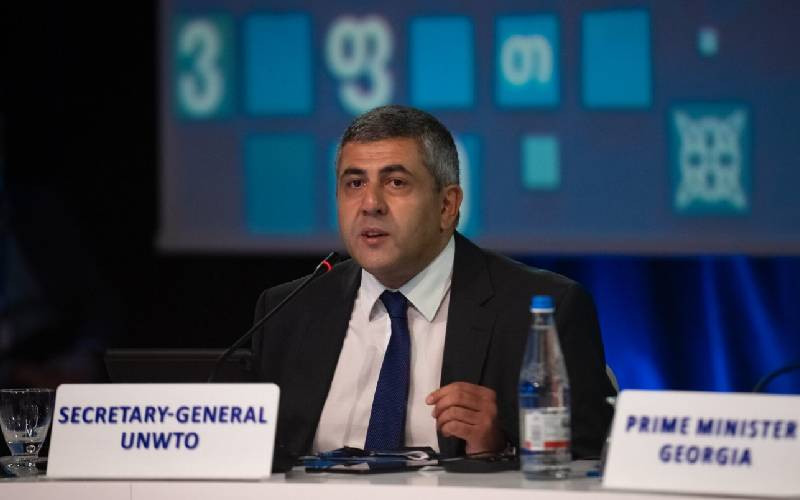By Juma Kwayera
Before leaving for Doha, Qatar, the Kenya Wildlife Service (KWS) delegation took pictures of the flora and fauna at the Nairobi National Park.
The pictures were to provide the necessary "visual effect" to the longstanding debate on the kind of rich biodiversity Africa is set to lose to illegal trade in endangered species. Top on the list are the elephant, the lion, rhino or tortoise — all of which made the agenda of the 15th Convention on Trade in Endangered Species (Cites) taking place in the Qatari capital.
Cites secretariat rescheduled twice the heated debate on the fate of African elephant stocks, underlining the gravity of the issue in which there were pointers by the close of the week Kenya would carry the day.
 |
Debate rages on the fate of Africa’s diminishing elephant stocks. |
 |
KWS director Julius Kipngetich. Photos: Jacob Otieno/ Standard |
A KWS official, Mr James Njogu, who is attending the conference, told The Standard on Saturday the bids by Tanzania and Zambia seeking a one-off sale of their ivory stockpiles were unlikely to get the nod after the secretariat questioned the two states’ technical capacities.
Njogu said the Cites secretariat had declined to support "Tanzania’s proposal on grounds of weak law enforcement and compliance".
However, he said: "Zambia’s proposal is being supported by the Cites secretariat, but we are lobbying against it noting their data is not correctly presented."
A report by Cites panel of experts that was in Tanzania recently said although the country’s stocks were healthy, it lacks the capacity to enforce compliance with international regulations on trade in endangered flora and fauna.
Biological criteria
The report noted: "The secretariat is of the opinion the proposal demonstrates that the population of loxodonta africana (African elephant) of Tanzania does not meet the biological criteria for its retention in Appendix I. However, as evidenced by the findings of the Panel of Experts, the secretariat is concerned about the precautionary measures in place regarding enforcement and compliance."
The view, said Njogu, is a welcome verdict on conservation of Kenyan stocks, which have massed from below 23,000 in 1979, when an international ban on trade in elephant tusks came into effect, to the current 35,000-plus.
The Tanzanian proposal has been undermined by the secretariat, which says further: "Anti-poaching efforts in some parts of the country seem inadequate, the ivory stocks cannot be fully verified and controls of illegal trade in raw ivory originating from or transiting through Tanzania appear to be unsatisfactory. For these reasons, the secretariat recommends the proposal be rejected."
Down-listing
In the build-up to the conference, 23 of 37 African elephant range states rallied behind Kenya and Mali’s joint proposal to retain the African Elephant in Cites Appendix I (the group of species endangered with extinction).
The proposal ran counter to a bid by Tanzania and Zambia that were pushing for the down-listing of the African elephant to Appendix II, the group of species in which controlled trade is allowed.
As was the case during the Cites meeting at Gigiri, Nairobi, in 2000, Kenya rallied international support against proposals by 13-member South African Development Community (SADC) bloc with help of visual power, using pictures of its rich biodiversity, but which is on a steep decline, to defeat the proposal. At the time, SADC wanted to be allowed to dispose of about 150 tonnes of stockpiled ivory.
It was the same strategy the Kenyan delegation used to tip the balance in its favour at the conference that was preceded by intense lobbying and campaigns to shoot down the proposals by Tanzania and Zambia, seeking to be allowed to dispose 113 tonnes of ivory on international markets in Japan and China.
In response to inquires by The Standard on Saturday about the support Kenya’s proposal had elicited, KWS Director Julius Kipngetich said of the photographs of the country’s flora and fauna displayed at the conference: "Beautiful and this is what we are defending in Doha. This is where Kenya’s competitiveness is and no country can copy this."
International trade in ivory has been the single most contentious issue considered by Cites parties since Conference of the Parties (CoP) 7 in 1989.
Ivory trade, both international and domestic and the protection of elephants from poaching for ivory, have dominated the meetings of the CoP to Cites since the time.
Source of acrimony
As the Cites secretariat considered Zambia and Tanzania’s proposals, southern African states reinforced their demands by seeking to delete an annotation regarding elephant populations in Botswana, Namibia, South Africa and Zimbabwe.
The annotation, which has been a source of acrimony among elephant range states provides: "No further proposals concerning trade in African elephant ivory, including proposals to down list elephant populations from Appendix I to Appendix II, shall be submitted to the Conference of the Parties for the period from CoP14 and ending 20 years from the date of the single sale of ivory in November 2008. Following this 20-year resting period, any elephant proposals shall be dealt with in accordance with Decisions 14.77 and 14.78."
The specific reference to Appendix II means the species in Appendix I were open to proposals for the sale during the period of the moratorium.
The omission as it were put Kenya and Tanzania on a collision course, with African Elephant Coalition (AEC) comprising of 27 countries in East and West African accusing Cites secretariat of favouritism.
In response, Cites Secretary-General Willem Wijnstekers said: "The allegations I have read, which suggest the secretariat somehow manipulated the wording to alter the scope of a moratorium, are wholly without foundation."
Fears of poaching
The secretariat came under fire when it published annotations on Appendix II that left out Appendix I, stoking controversy that has seen the AEC seek and obtain the support of the EU and the US.
More fundamentally, African elephant range states opposed to the one-off sale proposal fear it is likely to trigger poaching, which Kipng’etich says surges in the countdown to the Cites conference in anticipation of resumption of international commerce in ivory trade.
"By proposing to transfer the elephant populations of Tanzania and Zambia from Appendix I to Appendix II, Proposals 4 and 5, in effect, are preparing the ground to recommence trade in ivory in the near future. Acceptance of this at CoP15 in Doha would send the wrong signal to the unscrupulous traders and poachers who flout the law," AEC said in a joint communiquÈ ahead of the conference.
According to KWS, a dramatic resurgence in poaching is the worst since the international ban, with 232 poached elephants last year, 145 in 2008, 47 in 2007. In Chad, elephant stocks at the Zakouma National Park plummeted from about 3,800 in 2005 to around 617 now and illegal trade following the Cites-approved one-off sales in 2008.
The sales took place in 1999 and 2008 and earned some $20 million (Sh1.6 billion) for elephant conservation and community development programmes within or adjacent to the elephant range.
As the conference got underway, Wijnstekers reminded "the proponents that oppose ivory trade of the importance to consult African elephant range states on their proposal."
 The Standard Group Plc is a multi-media organization with investments in media
platforms spanning newspaper print operations, television, radio broadcasting,
digital and online services. The Standard Group is recognized as a leading
multi-media house in Kenya with a key influence in matters of national and
international interest.
The Standard Group Plc is a multi-media organization with investments in media
platforms spanning newspaper print operations, television, radio broadcasting,
digital and online services. The Standard Group is recognized as a leading
multi-media house in Kenya with a key influence in matters of national and
international interest.
 The Standard Group Plc is a multi-media organization with investments in media
platforms spanning newspaper print operations, television, radio broadcasting,
digital and online services. The Standard Group is recognized as a leading
multi-media house in Kenya with a key influence in matters of national and
international interest.
The Standard Group Plc is a multi-media organization with investments in media
platforms spanning newspaper print operations, television, radio broadcasting,
digital and online services. The Standard Group is recognized as a leading
multi-media house in Kenya with a key influence in matters of national and
international interest.











